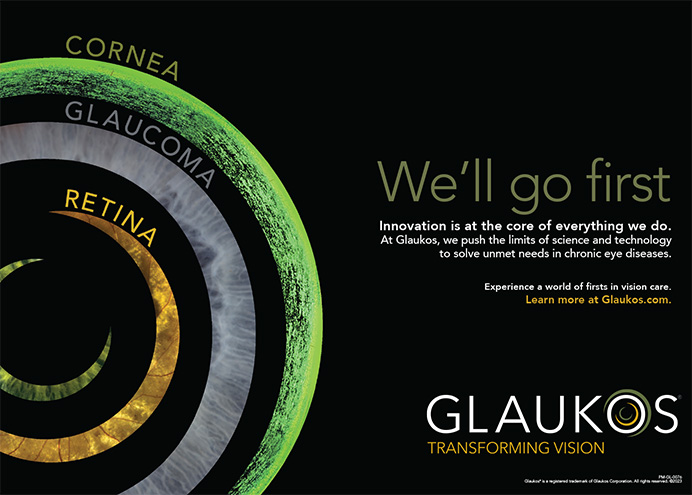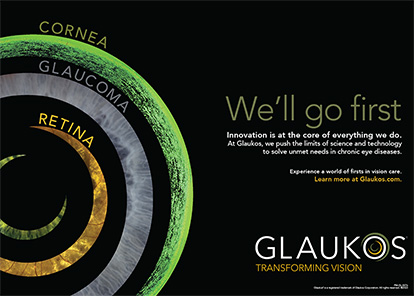CASE PRESENTATION
A 63-year-old man is referred for a cataract surgery consultation. His vision is correctable to 20/20, but he has severe glare symptoms. Brightness acuity testing is 20/60 OU largely due to grade 1+ to 2+ posterior subcapsular cataracts. He would like “the best implant money can buy” so that he doesn’t have to wear glasses. He has trace corneal guttata in both eyes and minimal changes to the retinal pigment endothelium (RPE) on macular OCT.
QUESTIONS FOR THE PANEL
1. How would you frame the conversation regarding the patient’s comorbidity and desire for spectacle independence?
2. Would you offer the patient a presbyopia-correcting IOL—trifocal, bifocal, or extended depth of focus (EDOF)—or advise them to consider an alternative option?
3. How would you respond when the patient asks, “What would you do if you were in my shoes, Doc?”
4. An IOL exchange can be tricky, especially if the initial surgery took place many years ago. Some studies have suggested that meticulous capsular bag cleanup and capsule polishing reduce the risk of complications with an IOL exchange. Have you modified your cataract surgery technique to anticipate the potential need for an IOL exchange?

Nicole R. Fram, MD
The main challenge here is helping the patient understand both the limitations of current technology and the potential complications he may encounter in the future due to his anatomy.
OCULAR ANATOMY
I would begin the preoperative discussion by focusing on the patient’s ocular anatomy. With the assistance of the engagement software Rendia (Rendia) on exam mode, I would explain to him how eyes work and show him both the location of the cataract and the compromised parts of his ocular anatomy such as his cornea and retina. Pachymetry readings and an endothelial cell count can also be useful information to share for prognostic analysis and demonstration.
I would explain to the patient that there is no perfect IOL technology that can free people from glasses for absolutely everything. I would tell him that the goal of surgery is to reduce his dependence on spectacles but that he should expect to use glasses in some circumstances. He must also understand that his outcome is somewhat unpredictable in that he may require an endothelial keratoplasty in the future. In my experience, however, the risk is low in someone with trace guttae and normal pachymetry.
CANDIDACY
Patients are presenting for cataract surgery earlier, and they have increasing expectations for postoperative spectacle independence. I would therefore thoroughly explain to the patient why he is a candidate for some technologies but not others.
I would begin by telling him that multifocal IOLs are designed to provide focus at distance, intermediate (60 cm), and near (40 cm). I would caution him that the technology may not perform well in his eyes because it splits light, which could decrease his contrast sensitivity and quality of vision owing to his retinal pathology and corneal guttae. Next, I would tell him that EDOF IOLs could provide him with good distance and intermediate vision but that he would need to wear glasses to read. I would note that EDOF technology stretches (Clareon Vivity, Alcon) or splits (Tecnis Symfony, Johnson & Johnson Vision) light, depending on the IOL design, so again, he may experience a reduction in contrast and quality of vision because of his underlying pathologies.
In my opinion, mini-monovision with monofocal IOLs is the best strategy for the patient. With it, I would explain, he can expect to be free of glasses for approximately 80% of his daily activities.
The Light Adjustable Lens (RxSight) is another option if the changes to the RPE are not actually drusen or classified as age-related macular degeneration; the Light Adjustable Lens is not recommended for this patient population because of the unknown long-term effects on the retina of the UV light treatments. There are two reasons why I would recommend the Light Adjustable Lens to the patient in this case: (1) it could permit the use of a customized monovision strategy with less of an offset between the eyes because of the lens’ EDOF-like property after UV treatment, and (2) there is an increased probability of hitting the desired refractive target because the IOL power can be adjusted postoperatively. Thorough polishing of the posterior capsule would be required. If fibrosis is present, the posterior capsule would be opened with an Nd:YAG laser before the postoperative UV light treatments. I would emphasize to the patient the limitations of the technology and the risk of endothelial failure.
A third option for the patient is mini-monovision with a new-generation monofocal (Tecnis Eyhance, Johnson & Johnson Vision). Postoperative visual recovery would be shorter than after the implantation of a Light Adjustable Lens, but customized monovision would not be possible.
CONCLUSION
Most important is to avoid being pushed into implanting an IOL technology to please the patient and hope that problems will not arise. Informed consent should be thoroughly documented, and it should carefully outline why he is or is not a candidate for various IOL technologies. The patient must understand the options, but it is the surgeon’s responsibility to guide him and recommend an appropriate choice given his comorbid conditions.

Chad Hummel, MD
Whenever patients ask for the “best lens money can buy,” I explain that no IOL is perfect and all of them involve compromises. The goal, I tell patients, is to choose the compromise with which they are the most comfortable.
OCULAR COMORBIDITIES
Fuchs corneal dystrophy and changes to the RPE can affect the performance of a premium IOL. I would explain to the patient that diffractive multifocal IOLs split light to provide distance and near vision. I would add that, if the Fuchs corneal dystrophy becomes more severe or he develops macular degeneration, he may not see as well as he would if he receives a monofocal IOL—especially in dim light.
I tell patients that there is a small chance they will need an IOL exchange if they are not happy early in the postoperative period. I note that an IOL exchange becomes significantly more difficult and may not be a viable option years after the original surgery, which is when they may experience progression of an ocular comorbidity. If a patient is willing to accept these risks, I am comfortable implanting a presbyopia-correcting IOL.
CAUTION: GLARE
I am cautious about offering a presbyopia-correcting IOL to someone whose BCVA is 20/20 and who complains of glare. In the past, I steered these patients away from presbyopia-correcting IOLs, but one case changed my perspective.
A 48-year-old patient presented with significant posterior subcapsular cataracts and complaints of glare. Their BCVA was 20/25 OU with a minimal refractive error. Nondiffractive EDOF IOLs were not available at the time. I recommended and implanted a monofocal IOL to correct the glare completely.
Postoperatively, the patient was unhappy with their near vision and opted to exchange the monofocal IOL for a trifocal IOL. The patient was extremely happy with their final vision and, based on their experience with both options, suggested I not even offer monofocal IOLs.
PREOPERATIVE REFRACTION
When I discuss multifocal IOLs with patients, I usually explain that the technology allows them to read better without spectacles but at the tradeoff of a slight reduction in their night vision.
A key piece of information missing from the case presentation is the patient’s current refraction. This would reveal a lot about his expectations for postoperative reading vision and might help guide IOL selection. For example, if he has a preoperative refractive error of 4.00 D, the patient would likely be satisfied with an EDOF IOL, which should reduce the glare he is experiencing and be less affected than a diffractive multifocal IOL by the future progression of his preexisting comorbidities. I would be less inclined to offer an EDOF IOL if his preoperative refractive error is -3.00 D because he would surely notice a significant decrease in his reading vision after surgery. A monovision strategy or the implantation of a multifocal IOL would be more suitable options in this situation. If the patient’s preoperative refraction is close to plano, then his age is a big factor in his near vision expectations.
WHAT WOULD YOU DO IN MY SHOES?
Whenever patients pose this question, I ask them whether their primary visual goal with cataract surgery is to see at near without glasses or to eliminate glare. They may find it helpful to use an online glare simulator to compare vision with a monofocal and a multifocal IOL.
If glare is the patient’s main issue, implanting an EDOF IOL with a slightly myopic target (-0.50 to -0.75 D) in the nondominant eye may be the best option. If reading without spectacles is his primary goal, a multifocal IOL would provide a fuller range of vision.
The goal of surgery is to deliver a visual outcome that satisfies the patient. Preoperative counseling about his comorbidities is warranted, but ultimately the decision on if and how to proceed is his. I have patients who received a presbyopia-correcting IOL and subsequently developed significant epiretinal membranes and lost 2 to 3 lines of BCVA. It is difficult to say what impact the IOL had on their BCVA, but none of the patients has expressed regret about the IOL they chose.
If the patient understands the risks and is happy postoperatively with a presbyopia-correcting IOL, I would stress the importance of regular eye exams. I would not, however, be overly concerned that the IOL will become an issue in the future.

Arjan Hura, MD
It is important to educate patients about their ocular anatomy, refractive error, and comorbid conditions (if present) and to take their chief complaint into account before committing to cataract surgery. In the case presentation, the patient’s chief complaint appears to be severe glare symptoms due to posterior subcapsular cataracts. The patient desires spectacle independence, and although it appears financial cost will not limit his access to the most sophisticated IOL technology, his comorbid pathology and his current chief complaint are notable. Several options exist, including next-generation and enhanced monofocal, EDOF, and multifocal IOLs.
AREAS OF CONCERN
If the patient desires complete spectacle independence, the strongest near vision will likely be conferred with multifocal IOL technology. Each iteration of diffractive multifocal IOL technology is becoming more refined than the last, but the optical laws of physics cannot be cheated. The preoperative discussion should include the inherent side effect profile of multifocal IOL technology, including the potential for glare and halos after surgery. This potential exists for any IOL technology, but the risk is higher with multifocal IOLs. In my experience, patients who suffer from severe glare and halos before cataract surgery are often dissatisfied if similar symptoms manifest after surgery.
Individuals with significant preexisting or progressive ocular comorbidities must be counseled on how their condition may influence their immediate and long-term outcomes with diffractive multifocal IOLs. The trace guttae and changes to the RPE likely will not affect the quality of vision the patient achieves with a diffractive multifocal IOL in the short term. Disease progression, however, may lead him to be unhappy with his quality of vision in the future owing to worsening contrast sensitivity.
OPTIONS
The question we face often is whether to plan surgery based on a what if scenario that may never happen or to focus on achieving a 20/happy result for most if not all of the rest of the patient’s life. These are not simple considerations and warrant a thorough discussion with the patient and informed consent. If he is willing to accept that he may experience glare and halos after cataract surgery and that his quality of vision may deteriorate if his comorbidities progress later in life, then a multifocal lens such as the Clareon PanOptix (Alcon) or Tecnis Synergy (Johnson & Johnson Vision) is a good option to give the patient spectacle independence.
Excellent alternative options are available that can provide a wide range of vision without the use of diffractive optics. Examples include an EDOF IOL such as the Clareon Vivity, a new-generation monofocal IOL such as the Tecnis Eyhance, and the RayOne EMV (Rayner) for enhanced monovision. These IOLs do not use diffractive optics, so theoretically, they are less likely to degrade the patient’s quality of vision if the corneal guttae or RPE changes progress. However, should endothelial keratoplasy or posterior segment intervention be required in the future, then a hydrophobic IOL such as the Clareon Vivity or Tecnis Eyhance would be the better alternative option.

Saj Khan, MBBS, FRCSEd(Ophth)
The initial consultation is an opportunity for surgeons to determine whether we can be a good partner in a patient’s vision-optimization journey. Some clinical scenarios are black and white, but others such as the case presented inhabit a grey area. The latter situation seems to be growing more common as we develop a greater understanding of subtleties that can adversely influence outcomes but also as we are surprised when outcomes exceed our expectations.
AN EYE TO THE FUTURE
Nothing in the patient’s history prevents us from targeting a full range of focus outcome in the short term. The challenge lies in accounting for potential developments during the next 20 or more years and how our choices now may precipitate his awareness or affect the management of future visual problems. Specifically, there is no way to be certain whether or when the pigmentary macular changes may develop into macular degeneration; how severe the disease, if it develops, and significant its impact on vision may become; or whether the trace guttae may become full-blown Fuchs endothelial dystrophy.
I prefer the term increased range of focus (IROF) IOL to presbyopia-correcting IOL. Regardless, the greater the range of focus an IOL delivers, the greater the demand it places on the visual system to process the vison and the greater the loss of light energy/contrast at any distance. These losses are rarely significant in patients with healthy visual systems and are typically outweighed by the advantages of reduced spectacle dependence. Nevertheless, the implantation of an IROF or full range of focus (FROF) IOL demands a compromise—however insignificant it seems to patients in the near term—and has the potential to amplify visual compromises introduced by the future development of ocular pathology.
If the health of the patient’s macula degenerates, not only may he lose the benefits of an IROF IOL but the compromise introduced by the IOL may give him a greater and earlier awareness of his visual symptoms caused by disease than he would have with a standard monofocal IOL. Additionally, if the patient develops Fuchs dystrophy, the guttae may compound any glare or dysphotopsias generated by a premium IOL.
COUNSELING THE PATIENT
Before undergoing surgery, the patient must be educated about the compromises involved with each IOL technology, how they may affect him in the future, and the implications for the management of ocular pathology. Further deterioration of the anterior or posterior segment could render him intolerant of an IROF IOL and necessitate its removal. The complexity of and risks associated with an IOL exchange are a topic for a separate article. The preoperative education of the patient, however, must include the following:
No. 1. Macular degeneration increases the risk of macular edema and epiretinal membrane formation after an IOL exchange, which is typically more complex than primary cataract surgery. This risk is further increased in the presence of an open posterior capsule—a more likely scenario in the early postoperative period after a posterior subcapsular cataract—and may cause additional acute and permanent visual loss.
No. 2. The risk of corneal decompensation increases with every intraocular surgery performed. Eventually, this could necessitate a corneal transplant.
IOL SELECTION
A hydrophobic acrylic IOL would be my preference to avoid potential IOL opacification if the patient requires a vitrectomy with gas tamponade or endothelial transplant with an air/gas bubble in the future. I would advise him that the implantation of monofocal IOLs in both eyes, either with paired distance focuses or a monovision strategy, would be the least optically demanding option while also allowing some reduction in his postoperative dependence on spectacles.
If the patient desires a fuller range of focus than the aforementioned approach can provide, I would discuss with him the option of mini-monovision using a new-generation monofocal IOL such as the IsoPure (BVI Medical). This IOL uses spherical aberration to increase range of focus but induces negligible dysphotopsias or loss of contrast based on my personal experience.
If the patient is extremely motivated to achieve an full range of focus and both understands and accepts the short- and long-term risks, I would offer to perform a duet procedure, which combines the implantation of a monofocal IOL in the capsular bag with placement of a multifocal IOL designed for placement in the sulcus such as the Sulcoflex Trifocal (Rayner). Compared to the implantation of an EDOF or trifocal IOL alone, duet surgery makes reversing multifocality easier and poses less risk to the cornea and macula.
If I were in the patient’s shoes, I would elect mini-monovision with a new-generation monofocal IOL.

Mayank A. Nanavaty MBBS, DO, FRCOphth, PhD
The patient must understand that he has a potentially progressive eye condition. I would educate him on his options and situation using simple language.
PREOPERATIVE COUNSELING
Options. I would begin by explaining that there are three broad categories of IOL technology. The first is monofocals, which can provide spectacle-free distance vision but often require the use of glasses for intermediate and near vision. The second category is EDOF IOLs, which can provide a high level of spectacle independence for distance and computer work. Spectacles are required for close reading. The third category is trifocal IOLs, which are expected to provide all three ranges of vision and spectacle independence for most daily activities and in bright light. Trifocal lenses reduce contrast sensitivity. Moreover, rings in the optic can cause glare and halos that generally become less noticeable after a few months of neural adaptation. Trifocal lenses work best in bright lighting conditions.
Risks. I would outline the risks of cataract surgery to the patient. They include infection; inflammation; bleeding; retinal tears, holes, and detachment; cystoid macular edema; a need for further procedures; and short-term dry eye disease, floaters, and reduced vision. I would also emphasize that spectacle independence is not guaranteed and explain that the refractive outcome is influenced by the eye’s healing response.
Next, I would educate the patient on his unique risks. I would tell him that he has a low cell count on the inside layer of the front clear window (ie, cornea) of his eyes. These cells, I would continue, are essential to maintain the dehydrated state of the cornea. The cell count can decrease further after cataract surgery, and it can decline with age. If the count reaches too low a level, then the cornea may develop cloudiness, which can necessitate replacement of the cell lining with tissue taken from a donor cornea (ie, partial-thickness corneal transplant).1 If this happens, then his vision may change over time.
Additionally, the patient has experienced mild changes at the back of his eye (ie, retina). The changes may become more pronounced and affect his reading vision, color vision, and contrast sensitivity.
I would explain that there is a risk that his vision will change in the future if either of his preexisting conditions progresses and becomes more severe.
IOL SELECTION
Currently, the patient’s corneal and macular changes are mild and not visually significant. I would ensure that he clearly understands the pros and cons of all three IOL categories and the risks associated with his comorbidities in combination with each category. As mentioned earlier, I would caution him that he may need a corneal procedure in the future and that his reading vision may be affected by progressive macular disease. The final decision on how to proceed is the patient’s.
My answer to how I would proceed in his shoes is as follows: “Unfortunately, I do not live your life, and everyone’s expectations and requirements are different. I do not know all the details of your personal life, including your activities and hobbies or what your reaction would be to disappointment if your expectations are not achieved, and therefore it is not appropriate for me to suggest a specific option.”
1. Nanavaty MA, Ashena Z. Refractive lens exchange with a trifocal intraocular lens in Fuchs endothelial dystrophy. J Cataract Refract Surg. 2020;46(3):478-481.

Gary Wörtz, MD
I explain to every patient that no single IOL is the best choice for everyone. If such a technology existed, I would implant it in every eye. No currently available IOL, moreover, can compete with a perfectly healthy 20-year-old crystalline lens. The implantation of any IOL therefore involves tradeoffs that must be balanced against the patient’s visual needs, preferences, and ocular health. In most situations, side effects can be minimized and spectacle independence maximized if the person is willing to be patient as we work toward those goals. This work may include a postoperative excimer laser enhancement, an Nd:YAG laser capsulotomy, and a period of neural adaptation.
COMORBIDITIES AND IOL SELECTION
The patient is relatively young and highly motivated to achieve spectacle independence. His eyes exhibit signs of mild corneal and retinal pathology that likely will be of little importance in the coming months but could ultimately become problematic if they progress. Specifically, corneal guttae and changes in the RPE could negatively affect contrast sensitivity.
Both EDOF and trifocal IOLs reduce contrast sensitivity to increase range of vision. Most patients tolerate this trade-off well. I hesitate, however, to offer either technology to a person who has a history of refractive surgery or preexisting corneal or retinal pathology.
Regardless of my concerns, I would inform the patient of his options. I would explain the difference between diffractive trifocal and EDOF IOLs, nondiffractive EDOF IOLs, and the Light Adjustable Lens. If he has experience with monovision adaptation, I would strongly recommend the Light Adjustable Lens. Blended stereovision with this IOL is the only option that can maximize both the precision of the outcome and the tolerated near vision offset through a postoperative adjustment.
Ultimately, I would offer all IOL options to the patient with proper informed consent. His level of pathology is unlikely to affect his outcome in the near term, and it is impossible to predict the future. As stated earlier, however, trifocal and EDOF lenses will become less effective if the corneal and/or retinal pathology progresses. The patient must understand the risks before deciding how to proceed.
If I were in his shoes, I would choose the Light Adjustable Lens for its precision. The technology’s corrective pattern can be modified by contact lens wear or excimer laser surgery if either eye experiences visual impairment in the future due to disease progression.
EXCHANGEABILITY
The presented case highlights the long-term need for IOL exchangeability. Patients who receive IOLs while in their 60s can develop sight-changing pathology such as age-related macular degeneration, primary open-angle glaucoma, and Fuchs dystrophy years later. IOL technology, moreover, continues to advance. The option to exchange patients’ IOLs safely and easily in the future would allow them and their surgeons to select the best technology for the near term. If patients cannot tolerate the IOL or if their ocular health changes in the future, the IOL may be exchanged.




